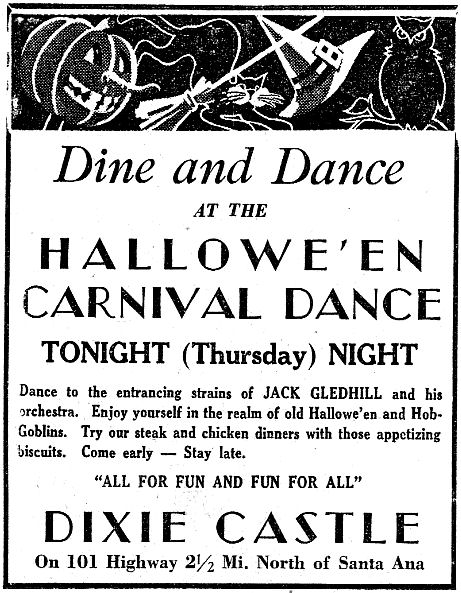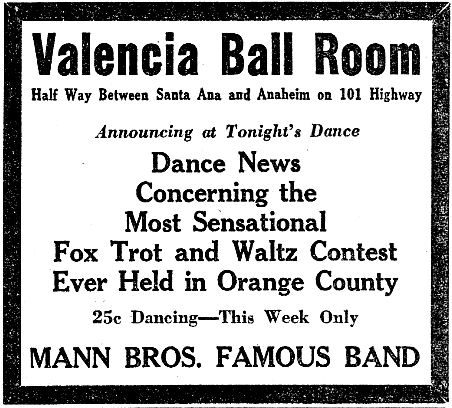Orange County Night Clubs
Looking for a fight? Or a cold beer? Or dancing ‘til 2:00? Then you’d want to head out along the state highway between Anaheim and Santa Ana, where some of Orange County’s rowdiest night spots were located – in the 1930s and ‘40s.
Like most stereotypes, the image of Orange County as nothing but a peaceful, pristine bastion of conservatism simply doesn’t hold up. It wasn’t anything the chamber of commerce wanted to brag about, but there was definitely a little night life here in the old days. Besides the coastal tourist towns, the best action was out along Manchester Avenue between Katella and Chapman. This was before freeways, so the big, wide boulevard was an important connection to Los Angeles. It was also something of a no-man’s land – not quite Anaheim, still north of Santa Ana, and definitely not Orange.
The first businesses out there were about what you’d expect along the state highway – a couple of little cafes and some gas stations. But before long, they began to spice things up, adding dance floors and live music. Roller skating rinks and a miniature golf course (all the rage back around 1930) soon followed.
The Log Cabin was one of the earliest (and longest lived) restaurants out on the strip. Over the years it was joined by the Orange Grove Chicken Shack (“Eat with your fingers”), the Blue Goose Inn, the Highway Tea Gardens (“A Delightful Place to Dine”), Armstrong’s Cafe (serving the “Monarch of all Hamburgers”), the Duck Inn, Henry’s Drive-In, the Dome Drive-In (which offered curb service), and others.
The Queen of the dance halls was the Valencia Ballroom, “Out Where the Crowd Goes,” which opened around the end of 1931. Admission was 25¢ for men with women free until 8:30, and no extra charge for dancing. It was owned by the Balboa Amusement Company, the same folks who ran the famed Rendezvous Ballroom. “[T]he Rendezvous maintained a reputation for wild innocence,” the Los Angeles Times noted years later, “unlike the Valencia Ballroom … which catered to a crowd as eager to fight as to dance.”
The Valencia was perhaps not as seedy at first. The Jack Fisher Post of the Disabled American Veterans held a big benefit there every year, the Orange County Garden Clubs had their flower shows there, and they even hosted a couple of benefits for the Orange County Police Officers Association and at least one big political rally for the Democrats in 1936. But none of this could compete with the Great Depression, and in 1938 the Valencia Ballroom was converted into a roller skating rink, which was still going as late as 1942.
For the sports-minded, the Orange County Athletic Club was the place to be. It featured boxing and wrestling, along with occasional dances and vaudeville shows. The club had moved around over the years, starting out along the state highway in Orana (West Orange) in 1923. Five years later it moved to Delhi (South Santa Ana), where Henry Foust was the big promoter. (The fact that he also ran most of the slot machines in Orange County in the 1930s was probably just a coincidence.) Finally in 1934 the club moved out to Manchester, near Orangewood. It was an open air arena with seating for up to 2,300. Top row seats were 35¢; ringside 75¢, and during the war servicemen got in for half price.
Or for a change of pace, there was also briefly a dog track on the old county fairgrounds site, about where State College crosses today. About a thousand people came out to watch the greyhounds run for the first time in May 1935. Future plans called for adding lights for night racing, and maybe even hosting pro football games in the arena. But all this was based on the hope that California was going to legalize gambling. But when Gov. Merriam declined to sign the bill, the dog track project folded up.
Other night clubs along Manchester included the Dixie Castle (originally known as the Hi Hi Cafe and later known as the Flamingo Room), which opened in 1934 offering dinner and dancing to live music. “All for Fun and Fun for all,” their ads promised. The owners built a new restaurant next door in 1946 and re-opened as Max’s Cafe, “Orange County’s Most Ultra-Modern Restaurant and Night Club.” It was still jumping as late as 1955.
The Chez Paree opened in 1936, offering dinner, dancing, a cocktail lounge, and three floor shows a night. It was replaced by the College Inn three years later, which promised “attractive” waitresses and an all-girl band, “Margo and her Six Versatile Collegians,” offering “scintillating rhythm” at 9:00, 11:00, and 1:00 a.m.
But the seediest spot on the strip was probably the South Seas Club, which opened around 1938. It shows up regularly in the Santa Ana Register in the 1930s and ‘40s – in the police news. They even paid to keep their own “special deputy” on site at one time. Besides the obligatory fist fights, it was raided more than once for its strip tease performances. In March of 1940, for example, June Morgan, 32, was arrested for her “fig-leaf” dance. “Sheriff’s officers in the audience were checking the place and announced themselves shocked when the girl did her dance. They claimed that the fig leaf was inadequate, and that she exposed her person to view of the noisy crowd.” “The fig leaf wasn’t very big, either,” said the arresting officers. “Taken to jail, Miss Morgan made bail, and appeared not much concerned about her arrest.” (Orange Daily News, March 4, 1940).
Not that this stopped the South Seas. Ads in 1949 invited guests to come see “Dimples” Morgan “Do her famous strip” seven nights a week. It was still going as late as 1954 as the South Seas Supper Club.
But by then, the Santa Ana (I-5) freeway had come through, taking out most of the businesses on the east side of Manchester. Orange County’s increasing urbanization took care of the rest. Today, Manchester survives as little more than a choppy frontage road, with no reminders of its lively past.
This is the only photo I have yet found of any of the hot spots out on Manchester Avenue. It was taken during the floods of 1938, looking north along Manchester about where State College comes down today. Bob’s Place (or Bob’s Barbecue) is on the corner. Besides burgers, malts, and chicken pies, it was sometimes busted for serving alcohol to minors.



